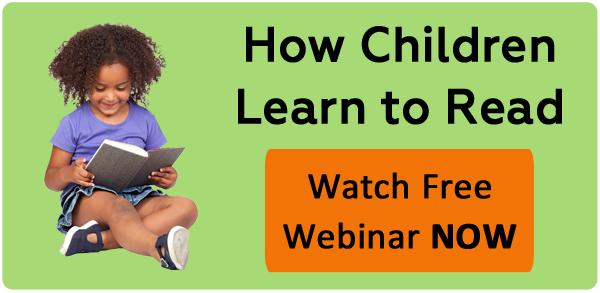
Over one-third of the fourth graders in America can’t read.
This number hasn’t changed in the past 10 years. You might ask, ”What is the problem?”
Reading instruction for the most part hasn’t been based on science, but instead has been based on ideas such as whole language or phonics, without systematic testing of hypotheses or observations and retesting of methods that seem to be working.
Research done by the National Institute of Child Health and Human Development shows that when an instructional method includes phonemic awareness, phonics, reading fluency, vocabulary and reading comprehension, the failure rate of our fourth-graders drops from 38% to between 2-7%.
Reading research is developing hard evidence that skills that lead to reading success are acquired before the age of six years. Vital skills include phonemic awareness (hearing individual sounds in a word), phonics (associating sounds with a letter symbol), visual patterning, vocabulary and the ability to relate information to your personal experiences.
Many preschools avoid academics, believing that teaching reading and math pushes children needlessly. If skill building is presented in a developmentally inappropriate way, such as drilling and worksheets, the child is hurried through the natural process of acquiring written language.
Preschoolers love to sing, talk, count, build and manipulate learning materials, and in the process learn critical skills without drills, tests or worksheets.
Sadly, almost 9 out of 10 of children who were poor readers at the end of first grade are still struggling at the end of fourth grade. Later as adults, 75% of these 9-year-olds continue to wrestle with reading.
Current research shows if a child hasn’t become a fluent reader by the age of 9 years, he or she will need 2 hours of intensive reading instruction per day for a year to catch up with peers.
These five skills will help your child, whatever age, learn to read successfully:
Phonemic Awareness:
This is the ability to hear the individual sounds in a word. For example the word dog has three distinct sounds: duh, aw and guh.
Phonics Skills:
This is the ability to take those letter sounds and connect the sounds to letter symbols, so you can sound out words.
In my experience with working with non-readers older than 9 years of age is this: These children can connect 6 or less letter sounds to their symbols. Once these older children learned to identify letter sounds and letters, reading moved along rapidly, with one student going from a first-grade level reader to an eighth-grade level in less than a semester.
Reading Fluency:
Beginning readers sound out words letter by letter. After multiple reading experiences with a word, the new reader memorizes that three symbols form a pattern to represent the word ”dog” and no longer needs to sound out each letter. Beginning readers need the practice of reading a single word at a time, gradually building to a few words on a page while developing memory and speed to create reading fluency. Many young readers want to jump to difficult books before they have the visual and memory skills necessary for fast and flowing reading.
Vocabulary:
If a word is not in our spoken vocabulary we will have difficulty reading and comprehending the word. For many of our children their small spoken vocabulary prevents them from understanding the written word. We might compare their problem with reading, as if we had picked up a book on nuclear physics. We might be able to sound out the words, but we wouldn’t understand much.
Reading Comprehension:
This skill is tied closely with vocabulary and with the skill of being able to relate information in the context of your life experiences. If a child is reading about a chrysanthemum and has never seen one or heard the word, odds are that the child will not understand what he or she is reading.
Current reading research suggest that we give our children under the age of six years learning opportunities in the following areas:
- To hear the distinct sounds or our language
- To connect sounds to letter symbols
- To build visual memory of patterns
- To have a language rich environment full of stories, songs and adult conversations
- To have hands-on experiences to enrich vocabulary
Research indicates that with these opportunities 95% or more of our fourth graders should read fluently. It’s time for a change.


Maren, I think I have asked you this question before but I ask again here b’cos I do have a 10 yr old boy in my class group who hasn’t yet learnt to read. So, my question is will the steps outlined here help him even though all these were tried when he was much younger and didn’t help then. He sings in tune beautifully and he loves to listen to being read.
Suseela,
Aloha! In my experience when you have a 10-year-old non-reader is this: when you go through all the sounds of the alphabet and the key phonogram sounds you usually discover that the child can only connect six letter symbols to their sounds.
So…we start back at the beginning teaching letter sounds and connecting those sounds to symbols.
Also, the Unscramble Spelling materials are extremely helpful in this case, because the child can see exactly what he needs to work on right now, today. It gives him hope and a direction.
You are in the Unscramble Spelling course, so I’ll send you the sign in information so you can review that.
You might also want to review the 4 part series on helping with reading, spelling and writing:
http://info.marenschmidt.com/spelling-reading-writing-info-series
Also, email me directly or from inside the Unscramble Spelling course if you have any questions.
Hi Maren!
Thanks for this article. Could you please list the references for the studies you cite? I am curious to read more.
Many thanks!
Louisa
Louisa,
Aloha!
I’ve added links to the major research articles in my Kids Talk article.
As you can see, the National Institute of Child Health and Human Development resource is a large study.
Please let me know if you would like other information.